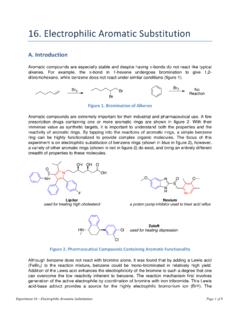Transcription of ELECTROPHILIC AROMATIC SUBSTITUTION NITRATION OF …
1 ANASAZI EXPERIMENT SERIES. ELECTROPHILIC . AROMATIC . SUBSTITUTION . NITRATION . OF methyl . benzoate . ANASAZI EXPERIMENT SERIES PAGE 2 of 5. DID YOU KNOW? The nitrogen in industrial nitric acid originates in the air you breathe, which contains 78 % nitrogen. Much of the nitrogen in the food we eat comes from synthetic fertilizers manufactured using nitric acid. AROMATIC nitro compounds are used as explosives, antibiotics, and synthetic intermediates in the production of dyes, foams, analgesics, antidegradants for rubber, and synthetic fibers. THE REACTION. THE MECHANISM. Nitric and sulfuric acid react to form the nitronium ion electrophile. Nucleophilic electrons attack the nitronium ion giving methyl 3-nitrobenzoate. STEP. 1 Sulfuric acid protonates nitric acid STEP. 2 Water leaves protonated nitric acid forming nitronium ion STEP. 3 AROMATIC electrons attack the nitronium ion electrophile STEP. 4 Conjugate base removes proton from ring restoring aromaticity ANASAZI EXPERIMENT SERIES PAGE 3 of 5.
2 THE MECHANISM. Sulfuric acid protonates nitric acid 1. Water leaves to form nitronium ion 2. AROMATIC electrons attack nitronium ion electrophile 3. Resonance structures Conjugate base removes proton from ring thus 4 restoring aromaticity ANASAZI EXPERIMENT SERIES PAGE 4 of 5. SPECTRA &. INTERPRETATION. methyl benzoate 1H NMR. (60 MHz, 1 scan, 11 seconds). 1. H NMR spectrum of methyl benzoate shows two multiplets in the AROMATIC region and one singlet upfield. Integration of the signals and understanding the deshielding effect of the methyl ester group helps further interpretation. methyl benzoate 13C NMR. (15 MHz, 30 pulse, 64 scans, 8 minutes). Because methyl benzoate possesses symmetry, the 6 carbons of the benzyl ring do not appear as 6 peaks but as 4 (see inset). The carbonyl carbon nuclei resonates downfield at 164 ppm and the methyl ester carbon upfield at 53 ppm. ANASAZI EXPERIMENT SERIES PAGE 5 of 5. SPECTRA &. INTERPRETATION. methyl 3-nitrobenzoate 1H NMR. (60 MHz, 2 scans, 22 seconds).
3 The nitro group is a strong electron withdrawing group and enhances the preexisting deshielding from the methyl ester group. methyl 3-nitrobenzoate also lacks symmetry compared to methyl benzoate . methyl 3-nitrobenzoate 13C NMR. (15 MHz, 30 pulse, 256 scans, 31 minutes). Loss of symmetry means that the 6 carbons of the benzyl ring now resonante as 6 signals. No two carbon nuclei are magnetically equivalent. As in methyl benzoate , the carbonyl carbon resonantes downfield at 164 ppm and the methyl ester carbon resonantes upfield at 52 ppm.
